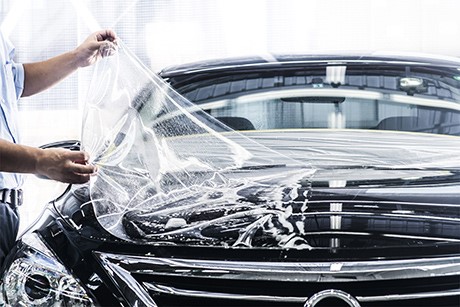You want to purchase a new car, and you want that car to never fade and just be brand new for the rest of the time. So your car will need to be protected for this to happen.
That being said, clear paint film or simply clear film are other terms for paint protection film (PPF). It is a self-healing thermoplastic urethane film placed on the painted surfaces of a new or old automobile to preserve the paint against stone chips, insect splatters, and small abrasions.
The film is also used on aeroplanes, cell phones, displays, electronics, motorbikes, and other applications.
Origin of PPF
PPF, like many other retail goods, were developed and introduced originally by the military. Throughout the Vietnam War, flying shrapnel and rubbish frequently damaged helicopter propellers and other sensitive components of military transporters.
So, to assist these working parts, the US armed services commissioned 3M to develop a solution that was both unnoticeable and light in weight.
The benefit of changeable film over replacing and repairing broken rotor blades was quickly apparent, and its acceptance was unusually rapid for the US armed services.
As a result, some in the industry still refer to PPF as “helicopter tape”. However, this name is decreasingly popular as automotive uses gain priority.
The Automobile Adoption of PPF
The military’s usage of PPF has lasted until the modern-day, and 3M today manufactures a large range of aerospace and military films.
However, over time, the automobile industry became aware of PPF’s defensive qualities, and it was shortly being used by racing car drivers, regardless of the difficulties of dealing with the original films.
Modern PPF for Automotive
Today’s automobile paint protection film is extremely acceptable and optically transparent, and it comes in a range of thickness (calculated in mils in the United States) and colours.
In addition, new formulations have multiple layers and a self-sustaining topcoat that can rebuild after becoming scuffed or damaged, retaining quality for over ten years.
Some suppliers’ products also have hydrophobic characteristics comparable to that of a paint ceramic cover.
Modern applications also necessitate slipping solutions or gel to prevent the sticking of film to the coloured panel. Hence, unique and specialised devices utilise steam, heated guns, and torches to attach film on difficult surfaces.
Installation Types Available
PPF can be installed in a variety of ways. For instance, plotter installation can be completed with software intended to produce a pattern based on the geometry of the panels, and then the film is finally put on.
You can adjust the software plotter layout to meet the demands of an installation or their client.
The most skilled installers can hand pattern panels and transfer them to the digital medium to cut it digitally by the software, transforming any bespoke work into a digital layout.
However, placing the film from its roll without a plotter poses a risk since the layout is sliced straight into the vehicle’s body.
Aside from installations conducted at the factories or by licensed shops and dealers, a few suppliers provide initial cutting and vehicle intended paint protective kits, also people selling these on internet auctions or other marketplaces.
PPF is intended to provide direct protection against minor debris and paint scratches. So, when it comes to maintaining your new car looking nearly new, PPF is the most complete and long-lasting option.



